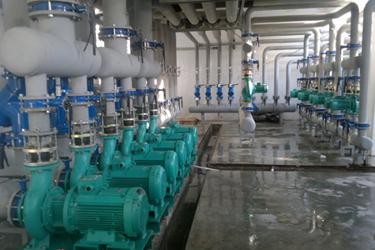Pump Selection 101: Understanding Essential Criteria To Maximize Reliability And Efficiency
By Peter Gaydon, Director, Technical Affairs for the Hydraulic Institute

Pump systems play a critical role in keeping our world in motion. However, specifying parties can often overlook opportunities to improve pump system reliability and efficiency. This can happen when designers or engineers fail to consider new demands placed on the system since installation or understand the benefits of available options. Often, the most significant opportunities missed stem from neglecting to see the big picture savings and efficiencies to be gained. When specifying a pump, whether for a new system or replacing an old one, there is certain criteria to consider. The usual checklist includes process liquid, flow, pressure, size and power, efficiency, space capacity, reliability, and cost. But there are many nuances to pump selection that can make big differences in performance, reliability, and cost-saving energy efficiencies. Here are five factors to always keep front of mind in pump selection:
- See The Big Picture
No matter the application, approach the process with the notion that a pump is selected to meet system requirements, and not the other way around. Defaulting to the traditional tried-and-tested solutions may not always yield the most effective option to improve performance, efficiency, and reliability. By designing for excellence across a complete system instead of addressing challenges in silos, engineers will be better positioned to maximize the impact of any improvements.
- Footprint Matters
Space availability and the pump system’s footprint are an important factor in the selection process. Given the accessible space, a frame-mounted (pump has its own bearing frame), close-coupled (motor bearings carry pump loads), or inline pump may be appropriate based on the power and speed requirements. However, these options will not have an interchangeable footprint.
Compared to frame-mounted pumps, commercial close-coupled pumps may be limited to 100 to 150 hp but offer space savings of around 20 percent. Alternatively, the use of inline pumps where applicable can dramatically reduce footprint. Similar to valves, inline pumps are designed so the flow enters and exits on a single axis, requiring minimal floorspace. As a result, inline pumps can occupy a third of the floorspace a typical frame-mounted pump occupies. So, know if space is at a premium, which pumps can help maximize it, and how those choices can impact other criteria. And remember that it’s not just about horizontal space — suitable vertical space is required, which is more important for the inline pumps that typically have a vertical motor above the pump.
- Think Smart
Often, there is opportunity to improve performance, efficiency, and reliability of a system. For example, utilizing smart pumps that integrate a variable frequency drive (VFD) that has the pump performance programmed in from the factory, instead of retrofitting
- Carefully Assess Flow Requirements And Fluid Properties
Fouling, corrosion, and erosion of pumps and pipes over time can be attributed to biological, chemical, and abrasive factors, so understanding fluid properties can be critical to avoid failure or the need for continuous and costly maintenance. Additionally, fluid viscosity and temperature are also critical considerations in the pump selection process.
Amid the global pandemic of COVID-19, many manufacturers drastically increased and continue to increase production volume to meet supply chain demand. Detergent, solvent, plastic, and gel manufacturers required greater volumes of olefins and aromatics. Should another similar scenario occur in the future, it could be advantageous of these manufacturers to re-examine the flow rate and pressure ranges that influence control methodologies to grant them greater flexibility.
For example, positive displacement pumps are often used in the industrial and petrochemical sectors and in many applications with viscous product. These pumps come in many designs, but generally deliver consistent volume with every rotation of the shaft, efficiently handling viscous liquids and delivering a nearly consistent flow against low or very high pressures. A benefit is that adding a variable speed drive allows these pumps to be dialed into a very precise flow rate, or possibly have their flow extended to meet future system demands.
- Make Energy Efficiency Part Of The Cost Assessment
A variety of factors for different settings can affect energy savings resulting in long-term potential for significant cost savings. Upfront costs can often deter specifiers from considering overall savings throughout a pump’s lifecycle.
For a typical pumping system, 65 percent of the total cost of ownership (TCO) is related to energy and maintenance, while the initial cost only accounts for 10 percent. For example, a double-casing between bearing multistage pump (BB5) will cost more than an axially split multistage pump (BB3), but the BB5 is designed for high reliability in high pressure and temperature applications. Trying to reduce cost upfront by extending the pressure and temperature range of the BB3 pump could result in a much higher TCO due to maintenance costs. Enhancing the energy efficiency of pumps can also go a long way to save on utilities. To help identify the most efficient pump for the system requirements, the Hydraulic Institute (HI) offers an Energy Rating Program for select pump types below 200 hp. Further details can be found at pumps.org/energyefficiency.
About the Hydraulic Institute (HI)
The Hydraulic Institute (HI) centers the pump industry around excellence and efficiency to power everyday life. HI’s mission is to advance the pump manufacturing industry by becoming the world’s resource for pumping solutions and advancements in the industry by: Addressing Pump Systems, Developing Standards, Expanding Knowledge and Resources, Educating the Marketplace, and Advocating for the Industry.
For more information on the Hydraulic Institute, visit www.pumps.org.
